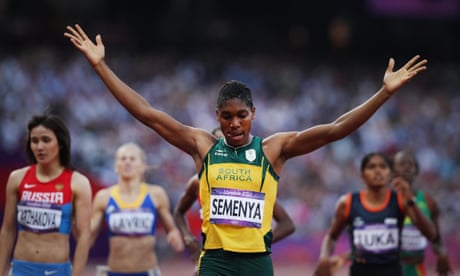Caster Semenya’s recent form can in part be attributed to the removal of an upper limit for women’s testosterone levels. Photograph: Tiziana Fabi/AFP/Getty Images
A sensitive and complicated issue has arisen many times, with the reversal of an IAAF rule on testosterone levels bringing it to the fore again
The return of Caster Semenya: Olympic favourite and ticking timebomb
The term “intersex” is used to describe variations in sex characteristics in someone who does not fit typical binary notions of male or female bodies. In sport the issue centres on verifying the eligibility of an athlete to compete in an event that is limited to a single sex. It is unquestionably a sensitive and complicated issue and one that has arisen many times at the Olympics and other sporting competitions where it has been alleged that male athletes have attempted to compete as women or, in Semenya’s case, that a woman has an intersex condition, which provides an alleged unfair advantage.
Over the years numerous sex or gender tests have been used to verify athletes’ eligibility, ranging from physical examinations to chromosome testing and more recently hormone testing. In the wake of Semenya’s case in 2009, testosterone testing was introduced to identify cases where testosterone levels were elevated above an arbitrary level, termed hyperandrogenism.

In April 2011, the IAAF announced it was adopting new rules and regulations governing the eligibility of females with hyperandrogenism, effectively meaning that there was an upper limit for women athletes’ testosterone levels – set at 10nmol/L – with anyone above it required to take hormones to lower them to more “normal” levels to compete.
That rule was in force until July 2015 and its reversal is among one of the key reasons why Semenya has returned to form in such emphatic fashion. The Indian sprinter Dutee Chand, who was dropped from the 2014 Commonwealth Games at the last minute, successfully appealed to the court of arbitration for sport who ruled that there was insufficient evidence that testosterone increased female athletic performance, suspended the practice of testosterone regulation and challenged the IAAF to present better evidence by July 2017.
Chand’s lawyers insisted she was not to blame for her genetic advantages, that the existing law was discriminatory against women – because men are not screened for high natural testosterone levels – and were able to demonstrate that the threshold set by the IAAF was arbitrary, hence the need to present better evidence within two years. In the meantime, it allows Semenya, Chand and other intersex athletes to compete without needing to take hormones to lower their testosterone levels.





























.png)








.mkv_000108708.jpg)
.mkv_000109059.jpg)
.mkv_000113988.jpg)
















+(Light).jpg)








































No comments:
Post a Comment